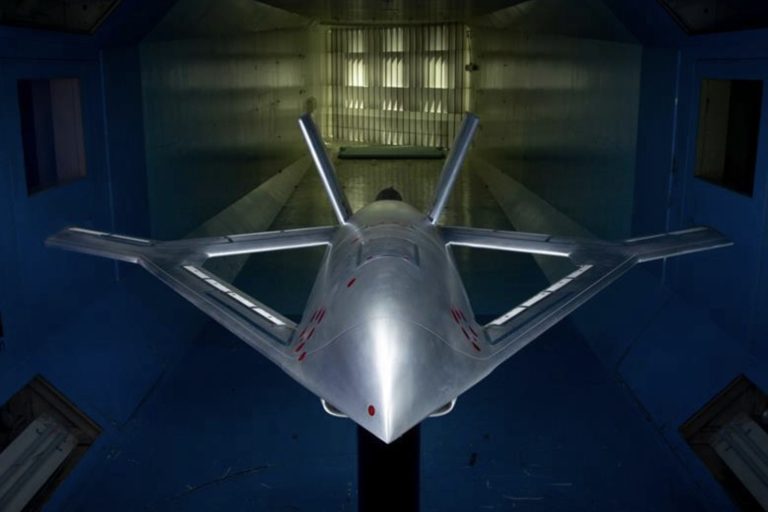The U.S. Department of Defense Advanced Research Projects Agency (DARPA) and Boeing's Aurora Flight Sciences are working side-by-side to produce an aircraft that uses compressed air instead of physical control surfaces, a revolutionary design that has the potential to reshape the future of aviation and military stealth technology. .
The pioneering prototype, known as the X-65, weighs 7,000 pounds and is designed to reach a top speed of Mach 0.7, Breaking Defense reported this month. The report says that the new plane could fly in the summer of 2025.
The Revolutionary Aircraft Control Using Novel Effects, or CRANE, program aims to break the mold of a fundamental feature of aviation's century-plus existence by using Active Flow Control (AFC) actuators to shape aircraft flight.
The X-65 will be built with conventional control surfaces and new engines, with gradual testing to “lock down” the conventional flight control surfaces and gradually expand the role of the flight controllers (AFC), according to the Breaking Defense report.
The report says the X-65 will serve as a valuable testing asset for DARPA and other agencies long after CRANE is finished. He adds that the X-65 is designed to be a “modular platform,” allowing it to be easily swapped out and serve as a test asset for DARPA and other agencies.
In January 2023, Asia Times reported that the X-65 is intended to serve as a testbed for new aircraft technologies with a focus on revolutionizing existing stealth technologies. The CRANE program is in line with the evolution of stealth aircraft, as combat aircraft must improve performance and become less expensive and more stealthy to maintain their superiority and strategic value.
Innovations in intakes and exhausts are needed to match the flying wing designs of future stealth aircraft. Advances in systems integration, miniaturization, actuators, sensors, and computing power have made AFC technology possible for military aircraft. At the same time, moving control surfaces can affect the aircraft's radar cross sections (RCS), potentially compromising stealth capability.
AFC is more desirable than passive measures such as conventional articulated flight control surfaces, as it can be turned on and off as needed. AFC technology offers multiple opportunities to improve aircraft performance including eliminating moving control surfaces, reducing drag, creating thicker wings, increasing fuel capacity, and simplifying high-lift systems.
Future stealth aircraft, such as the 6th Generation US Air Dominance (NGAD) aircraft, may use AFC technology to take advantage of the multiple advantages this technology offers.

In a January 2022 article for The National Interest, Alex Hollings noted that AFC could supplement or eliminate traditional moving control surfaces to improve aircraft flight performance and reduce mass and size compared to conventional control surfaces, enabling greater payloads, speed, lower maintenance requirements and leading to higher readiness rates. Operational.
Hollings points out that in situations where stealth is required, pilots can use AFC technology to broadly control the aircraft when flying in contested or heavily protected airspace, and then switch to traditional flight control surfaces for life-or-death situations where maneuverability is required such as in Air battles.
Next-generation drones may also feature AFC technology to improve their survivability in contested or heavily defended airspace.
In July 2022, Breaking Defense reported that the US Air Force plans to phase out its RQ-4 Global Hawk drones by 2027 to make way for newer drones more capable of survivability in contested and defended airspace.
The US Air Force has described the RQ-4 as a “legacy” platform that provides limited capability against near-peer threats. However, the Breaking Defense report notes that withdrawing the RQ-4 too early could leave a significant gap in intelligence, surveillance and reconnaissance (ISR) capabilities while a replacement is worked on.
The Warzone noted in an April 2021 article that the stealthy RQ-180 may take over the RQ-4's ISR role and serve as a high-flying information and networking node.
While details on the RQ-180's specifications are scarce, The Warzone describes it as a large, twin-engine, thin-winged, laminar-flow-optimized aircraft that was designed with highly advanced, wide-range and all-around stealth requirements.
The Warzone website states that the RQ-180 is intended to fly at high altitudes of over 70,000 feet for long periods without being detected. Later generations, or even a successor to the RQ-180, may feature AFC to enhance the already formidable stealth properties.
Moreover, the AFC may emerge among the next generation of combat drones designed to penetrate highly contested airspace and engage in fast-paced combat.
In September 2023, Asia Times reported on General Atomics and DARPA's “LongShot” program, a drone designed to launch air-to-air missiles for beyond visual range (BVR) combat.
While the LongShot drone can use AFC to maintain stealth while moving in contested airspace, it can also switch to using traditional control surfaces for air-to-air combat maneuvers.
Increased stealth may have refocused the spotlight on dog fighting skills, which had recently been de-emphasized in favor of BVR engagements. The increasing stealth of both fighters and drones means that opposing parties can end up within visual range (WVR) of each other, and inadvertently end up in close-quarters combat.
At the same time, AFC technology still faces significant technical challenges, especially regarding miniaturization and diverse applications.

In an October 2021 article published in the peer-reviewed journal Annual Review of Fluid Mechanics, David Greenblatt and David Williams note that energy efficiency represents a major challenge in applying AFC in flapping-wing micro- and nano-UAVs.
Greenblatt and Williams wrote that AFC systems do not have a dominant design philosophy or approach because of different control objectives, flight systems, and methods of operation. They state that design approaches vary depending on the application and specific goals.
Greenblatt and Williams also state that the practical application of AFC involves understanding the aerodynamics of control effects and their interaction with flight vehicle dynamics using methods such as empirical correlations, dimensional analysis, low-order modeling or high-resolution computational fluid dynamics.

